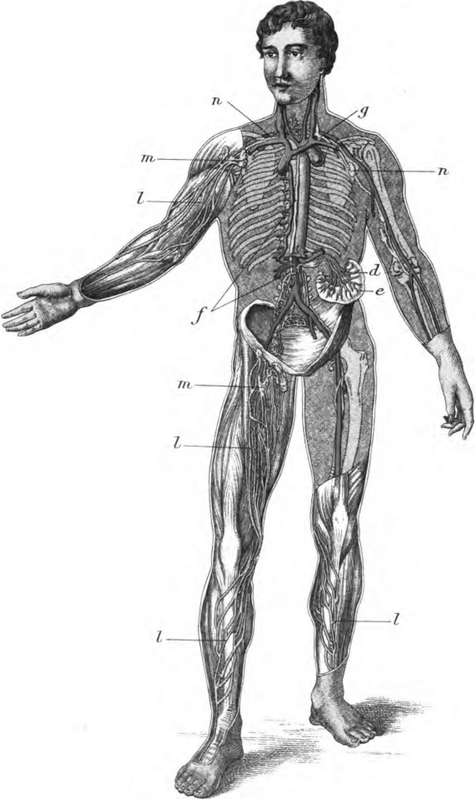Explanation Of Plate III. A General View Of The Lymphatic Or Absorbent System Of Vessels
Description
This section is from the book "The Human Body: An Elementary Text-Book Of Anatomy, Physiology, And Hygiene", by H. Newell Martin. Also available from Amazon: The Human Body.
Explanation Of Plate III. A General View Of The Lymphatic Or Absorbent System Of Vessels
e, A portion of the small intestine from which lacteals or chyle-conveying vessels, d, proceed, their origin within the villi may be seen magnified in fig. 51; f, the duct called thoracic, into which the lacteals open. This duct passes up the back of the chest, and opens into the great veins at g, on the left side of the neck: here the chyle mingles with the venous blood. In the right upper, and lower limbs the superficial lymphatic vessels l l l l, which lie beneath the skin, are represented. In the left upper and lower limbs the deep lymphatic vessels which accompany the deep blood-vessels are shown. The lymphatic vessels of the lower limbs join the thoracic duct at the spot where the lacteals open into it: those from the left upper limb and from the left side of the head and neck open into that duct at the root of the neck. The lymphatics from the right upper limb and from the right side of the head and neck join the great veins at n. m m, enlargements called lymphatic glands, situated in the course of the lymphatic vessels. These vessels convey a fluid called lymph, which mingles with the blood in the great veins. A fuller account of the lymphatic vessels in general, as distinguished from that section of them known as the lacteals, will be found on p. 214.
Absorption from the Stomach is more important. Food stays there a considerable time, and a good deal of the substances mentioned above as being absorbed to a slight degree on their way to the stomach, are taken up to a much greater extent by the mucous membrane of the stomach itself and passed on into the general blood current. In addition, a large proportion of albuminous food is turned in the stomach into peptones, which can be and are readily absorbed by the vessels of the gastric mucous membrane.

PLATE III. A general view of the lymphatics OB absorbents. That portion of them known as the lacteals is seen at d, passing from the small intestine e to the thoracic duot f.
Absorption from the Small Intestine is by far the most important in bringing nutritive matters into the body. The stomach is an organ rather of digestion than absorption; the small intestine, on the other hand, is specially constructed to absorb. Its valvul conniventes delay the progress of the food mass, which stagnates in the hollows between them; and its innumerable villi, with their bloodvessels and lymphatics (p. 167), reach out, like so many rootlets, into the chyle and take it up.
The sugars reaching the small intestine or formed in it are absorbed mainly by the blood-vessels and carried to the liver, where they are turned into glycogen (p. 171), which is heaped up in the liver during digestion, and slowly given out to the blood, as its sugar is used up gradually before the next meal. The peptones passed into the intestine from the stomach, or formed in it by the action of the pancreatic secretion, are partly taken up by its lymphatics and partly by its blood-vessels. The emulsified fats mainly pass into the lymphatics of the villi, and are carried off by them.
Why does more absorption take place from the stomach? Name things absorbed from both mouth and stomach? What food matters are first absorbed from the stomach?
Where does the most important food absorption occur? What structural peculiarities of the small intestine peculiarly fit it for absorbing?
What vessels absorb sugars In the small intestine? To what organ are these sugars conveyed? What there becomes of them?
Continue to:
